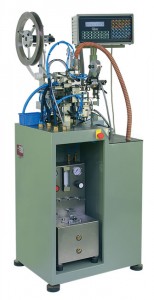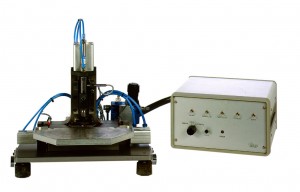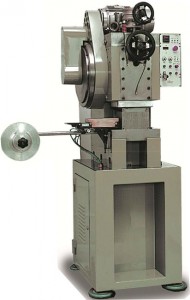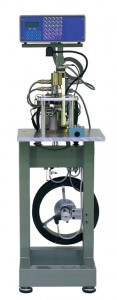The production of lobster clasps made on Ciemmeo machinery is basically broken down into 3 different phases in which 3 different sets of machines are required. The process foresees starting with flat stock of the (maximum) dimensions of roughly 40 x 0.70mm and 12 x 1.20mm. (The dimensions will vary according to the final sizes and weights required).
1st Phase – Stamping of the clasp shell.
The larger flat stock is fed into a coining/stamping press (mod. PS2S) which sees to the forming, shaping and cutting out from the flat stock of a symmetrically formed piece which when folded and soldered becomes the empty clasp shell. The forming/stamping process is carried out in four different stages within the die block itself.
It is a very delicate operation requiring a very high precision coining press such as the PS2S. In this process all of the necessary seats, walls, pivot points etc. of the clasp are created.
It is imperative that all of these be executed with the highest precision possible, as it is exactly these parts which will determine the correct and long functioning of the clasp. The shell of the clasp is almost completely cut out from it’s strip. In fact it remains attached to the strip in two separate points. In this way all of the shells are still left on the strip so as to facilitate the operation of the following machine (PSMA). The strip containing shells is automatically wound onto a spool by the press itself. The production speed of the unit is of 90 -110 pieces per minute.
2nd Phase – Production of the clasp trigger.
The smaller flat stock is fed into a coining/stamping press (mod. PS2S) which sees to the perfect forming, shaping and cutting out from the flat stock of a piece which is the trigger of the clasp. The exact forming of the trigger is imperative to the end product since it is in this process in which the seat of the spring is made in the trigger itself. For this reason we recommend the use not of a normal stamping press but of a press able to create the shapes and profiles necessary for such a product. As per the manufacture of the shells, there are no manual tasks for the operator except for loading the flat stock on the machine and then removing the finished triggers. The production speed of the unit is of 90 – 110 pieces per minute.

The spool containing the flat almost cut out shells are then loaded onto the forming and soldering unit (mod.PSMA) which automatically cuts them from the strip and feeds them to the folding apparatus. This then takes the piece, folds in two thus forming the shell and takes it over to the soldering station where it is automatically soldered shut with the use of either a laser unit or a gas flame and the addition of a small well dosed amount of alloy. The laser welding offers the benefit of faster speed, maintaining the purity of the original alloy since no other substance is added, and less deformity of the shell due to the absence of peripheral heat. At this point the closed shell is discharged for cooling off, before being passed on to the next production phase. The machine automatically carries out the full work cycle at a production speed of 50 shells per minute.
4th Phase – Assembly of the lobster clasp
Once having produced quantities of the shell and trigger, it is necessary to assemble these pieces together with a spring in order to obtain a functioning lobster clasp. The assembly of the lobster clasps is had in different modes; semi-automatic or automatic.
Semi-Automatic
The semi automatic mode of assembly also foresees two different modes:
Manual spring insertion
The individual springs are purchased on the open market and an operator manually inserts each spring into each trigger. The spring remains in position since it is inserted into the seat formed in the trigger.
Semi-Automatic spring insertion
This process is semi-automatic and does require little manual operation. The operator positions the trigger in a spring insertion unit (mod. MIM) which makes the spring from a spool of stainless steel wire and inserts it into the appropriate seat of the trigger. Once the machine has made the spring and thus inserted it int
Automatic
The shells and triggers are loaded into separate vibrating hoppers which see to automatically feeding them to the assembly mechanisms which will fully assemble and test the clasp. Also loaded onto the machine is a spool of stainless steel wire for the production of the spring. The procedure is quite simple, the machine (mod. MAMA1) is divided into different work stations which function simultaneously.
One station sees to making the spring and inserting it into its seat in the trigger itself. The trigger/spring assembly is then inser


